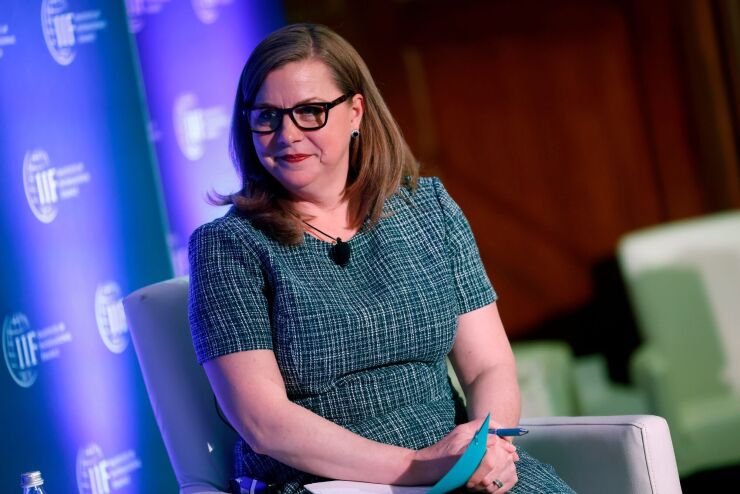Julia Nikhinson/Bloomberg
The Federal Reserve cited slower price growth and a softer labor market in its
Fed Gov.
On Friday, Bowman issued a statement explaining the rationale for her dissent. She pointed to concerns about resurgent inflation and a belief that the labor market remains strong enough to withstand tight monetary policy.
“We have not yet achieved our inflation goal,” she said. “I believe that moving at a measured pace toward a more neutral policy stance will ensure further progress in bringing inflation down to our 2% target. This approach would also avoid unnecessarily stoking demand.”
Bowman’s view of economic conditions stands in slight contrast to the evaluation shared by Fed Chair Jerome Powell after this week’s FOMC meeting. Powell said the group had grown confident that inflation was moving sustainably toward the central bank’s 2% annual target and that the balance of risks within the Fed’s dual mandate — keeping prices stable and unemployment low — had shifted away from inflation and toward the job market.
Fed Gov. Christopher Waller, in a Friday morning appearance on CNBC, took those views further, arguing that by some measures inflation has already reached the Fed’s long-run goal. He noted that recent readings from the Consumer Price Index and the Producer Price Index — both of which are maintained by the Bureau of Labor Statistics — suggest that the Fed’s preferred inflation measure, the Bureau of Economic Analysis’s Personal Consumption Expenditures index, would fall to an annualized rate of less than 1.8% over the previous four months.
Waller noted that he and his staff arrived at that estimate despite elevated housing services inflation. Were that measure of prices to fall to 2%, he said, the core PCE reading would be less than 1%.
“That is what put me back a bit to say, ‘Wow, inflation is softening much faster than I thought it was going to,'” Waller said. “And that is what put me over the edge to say, ‘Look, I think 50 [basis points of reduction] is the right thing to do.”
Bowman acknowledged that prices have come down substantially and that a reduction in the policy rate was appropriate, but noted that opting for a half-point cut instead of the Fed’s typical adjustment interval of a quarter point, “could be interpreted as a premature declaration of victory on our price stability mandate.”
On the labor side of the equation, Bowman pointed to low levels of layoffs as a sign that the employment outlook remains strong despite falling job vacancies and a modest uptick in unemployment claims. She is also skeptical of recent employment readings because of a string of revisions that have been issued regarding government surveys of the labor market — even though those revisions have tended to show fewer jobs added and higher unemployment.
“My reading of labor market data has become more uncertain due to increased measurement challenges and the inherent difficulty in assessing the effects of recent immigration flows,” she said. “I am also taking signal from continued solid growth in the spending data, especially consumer spending, reflecting a healthy labor market.”
The last dissenting vote in an FOMC meeting came in June 2022, when then-President of the Federal Reserve Bank of Kansas City Esther George opposed a 75 basis point increase to the Fed’s policy rate. At the time, she noted that the aggressive hike added to “policy uncertainty” when considered in tandem with the reductions to the Fed’s balance sheet, which also began that month.
Once a common occurrence — particularly between 1978 and 1987, when the committee averaged more than one “no” vote per meeting — dissents on the FOMC have been few and far between in recent years. This has been especially true for governors. Since 1995, there have been only two dissents from sitting board members, with the last one being Gov. Mark Olsen, who opposed a 25-basis-point hike in September 2005.
